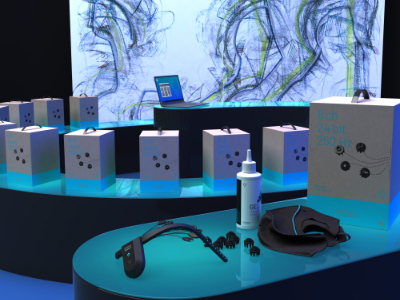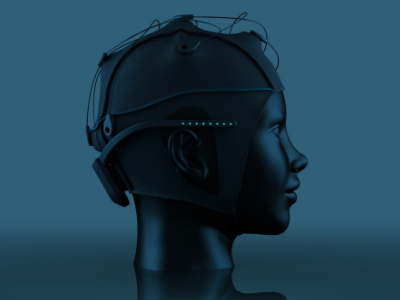BR41N.IO is a brainstorming and collaborative marathon designed to be a learning experience for developers, technologists, engineers, students, artists, and scientists who cram and build brain-computer interface (BCI) applications together in teams.
Who can participate?
Anyone can participate who has interests in BMI, BCI, robotics, AR, VR, machine learning, computing, sensors, human-machine interface systems, control, signal processing, big data, haptics, rehabilitation, and similar areas. Even better: it is for FREE.
Participants do not have to be a BMI expert to participate on a team! Interdisciplinary teams with a combination of BMI and non-BMI skills are often successful in building solutions and producing working prototypes.
I am a Unicorn Hybrid Black owner. How can I participate?
Do you have a Unicorn Hybrid Black at home or at your University/Institution? Great! Let's put together a team of students and participate with your own Unicorn Hybrid Black at the virtual BR41N.IO Hackathon. Our programming projects are most suitable for you.
Can I submit a different project?
Professional teams can also participate to develop applications during the BR41N.IO Designers' Hackathon to demonstrate full potential of some of the sponsored hardware/software.
If you are looking for additional skills from other team members, your project will be included among the BR41N.IO projects below for application. Submit your project to contact@br41n.io.
What's in there for me?
Be creative, think outside the box. The BR41N.IO Designers' Hackathon is fun and gets you to network and collaborate with other Geeks. The best BR41N.IO projects will be awarded with cash prizes:
PROJECT PRIZES Programming & Arts:
- 1st BR41N.IO Prize: $ 1,000
- 2nd BR41N.IO Prize: $ 600
- 3rd BR41N.IO Prize: $ 400
PROJECT PRIZES Gaming:
- 1st BR41N.IO Prize: $ 1,000
- 2nd BR41N.IO Prize: $ 600
- 3rd BR41N.IO Prize: $ 400
PROJECT PRIZES Data Analysis:
- 1st BR41N.IO Prize: $ 1,000
- 2nd BR41N.IO Prize: $ 600
- 3rd BR41N.IO Prize: $ 400
Sign up for a BR41N.IO project!
There are several predefined projects which you can choose to work on. Below, the projects are described in detail including hard- and software requirements.
The Unicorn Hybrid Black and the Unicorn Suite should be used to join a Programming Project. But, you can use your own hardware and software for the BR41N.IO hackathon. In case you don't have a BCI Headset, we recommend to join an Offline Data Analysis Project.
Meet your team virtually!
We will connect you with the team members of your project. Create your own virtual meeting space using Skype, Google Hangouts, Zoom, etc. to start working on your ideas.
Stay connected with us via Discord!
While you work on your groundbreaking new BCI applications, we are here to answer all the questions that might come up and support you wherever we can. Join g.tec's official Discord Server to connect with your team members!
Present your projects virtually and win!
You will be invited to present your results virtually via Zoom. Prepare yourself to explain what you did, what the results are and to show a demonstration (live or with a video) to the international audience and jury.
BCI PRINCIPLES
Brain-computer interfaces are realized by 4 different principles:
slow waves
steady-state visual evoked potentials (SSVEP)
motor imagery (MI)
evoked potentials (EP)
In the BR41N.IO Hackathon Series, motor imagery and EP based systems
are mostly used to control the applications:
In the case of the motor imagery application, participants have to imagine e.g. left or right hand movement to produce an event-related desynchronization over the sensorimotor cortex. This is basically an amplitude change of the alpha and beta regions of the EEG.
In the case of EPs, the BCI system is showing different flashing icons and the user has to attend to the icon he wants to select. When the icon flashes on the computer screen, than a P300 wave is produced in the brain and the BCI system is able to detect it.
FOR UNICORN HYBRID BLACK OWNERS
Do you have a Unicorn Hybrid Black, a Unicorn Naked BCI or the Unicorn Education Kit at your university or at your lab? Great! Let's put together 40 students in teams of 5 students and let them participate and compete against other international students at this virtual BR41N.IO Hackathon.
As Unicorn Education Kit owner, you'll qualify as a Hosting Institution for this BR41N.IO Hackathon. This means, you'll get a speaking slot during the hackathon and raise awareness for your university.
Unicorn Education Kit is perfectly designed for professors who teach brain-computer interfaces, biomedical engineering or signal processing.
It comes with 8 Unicorn Hybrid Black devices including full access to the Unicorn Suite software.


Unicorn Hybrid Black is a wearable 8-channel EEG device that measures high-quality EEG signals from your brain.
It is perfectly suitable for creating your own brain-computer interface or neuroscience applications.
HOSTING INSTITUTIONS
Universities who are proud owners of the Unicorn Education Kit automatically qualify as hosting institution. Official hosting institutions are fully embedded in the BR41N.IO Designers' Hackathons. Boost your institution’s visibility and awareness and benefit from a big audience.
Hosting institutions provide on-site access to EEG devices and brain-computer interface technology that you would need for programming projects. Just let us know at which hosting institition you would like to participate during the BR41N.IO Hackathon.
NOTE: Hackathon attendees will have access to computers, Unicorn Hybrid Black EEG headsets, and potentially other equipment like EMG, along with basic amenities such as water, coffee, and facilities. There will be no NDAs or IP ownership. Hosting institutions are not obligated to provide meals or support after the hackathon unless agreed upon; participants must also arrange their own travel and accommodation. Attendees are expected to use equipment responsibly, respect team members, and focus on learning, collaborating, and having fun!
Hackathon participants must adhere to the rules and regulations of the hosting institution if they choose to work on-site.
G.TEC
AUSTRIA
g.tec medical engineering GmbH
Dr. Christoph Guger
Schiedlberg, Austria
IEEE SMC CONFERENCE 2024
IEEE SMC 2024
Dr. Christoph Guger
Borneo Convention Center, Kuching, Malaysia
VRIJE UNIVERSITEIT AMSTERDAM
Department of Computer Science
Prof. Maryam Alimardani
Amsterdam, Netherlands
AALBORG UNIVERSITY
MeCIS Media Cognition & Interactive Systems
Prof. Luis Emilio Bruni, Niels Erik Raursø
København , Denmark
UAE UNIVERSITY
ABU DHABI
United Arab Emirates University
Prof. Abdelkader N. Belkacem
Abu Dhabi, United Arab Emirates
WEST UNIVERSITY TIMISOARA
Mathematics Faculty & Fine art and Design
Prof. Cosmin Bonchis & Prof. Camil Mihaescu
Timisoara, Romania
TEC DE MONTERREY
Campus Guadalajara
Javier Mauricio Antelis Ortiz, PhD.
Jalisco, Mexico
NYIT
VANCOUVER
Vancouver Campus, Dept. of Computer Science, Dr. Zhida Li
Vancouver, Canada
UNIVERSITY OF MELBOURNE
Department of Biomedical Engineering
Prof. David Grayden
Melbourne, Australia
CHONGWEN CULTURE AND EDUCATION
Hangzhou Chongwen Century City Experimental School, MSc. David Wiehls
Hangzhou, China
QUEEN'S
UNIVERSITY
NeuroTech Discovery Lab
Dr. Susan Boehnke, PhD
Kingston, Canada
UNIVERSITY OF TENNESSEE
Brain Autonomy and Resiliency (BAR) Lab
Prof. Saman Sargolzaei
Tennessee, USA
UNIVERSITY OF
VALLE
Perception and Intelligent Systems (PSI) Research Group, Prof. Humberto Loaiza Correa
Cali, Colombia
PSNC
POZNAN
Adam Olszewski, Ewlina Moszyk
Poznan, Poland
UNION
COLLEGE
807 Union Street Schenectady NY, USA 12308
Leonardo Ferrisi, Maya Mau, Ha Truong
New York, USA
HANGZHOU NEUROTX LTD.
BSc. Alex Zou, David Wiehls
Hangzhou, China
BMI SESSIONS & HACKATHON SCHEDULE
Time Zone: Time zone in Kuching (GMT +8)
Room: Borneo Convention Centre Kuching, Malaysia
Sunday, October 6
| 14:00 | Welcome Tiago Falk, IEEE SMC, Canada Christoph Guger, g.tec medical engineering GmbH, Austria Syed Abdul Rahman Al-Haddad, Universiti Putra Malaysia, Malaysia |
| 14:05 |
Current and Future Applications of |
| 15:00 |
How to run a Real-Time BCI Application |
| 15:30 |
Unicorn Brain Interface Demonstration |
| 16:00 |
Data Analysis Projects |
| 16:30 |
Group formation and START BR41N.IO |
| 17:00 | START OF BR41N.IO HACKING |
| 19:00 | High-performance EEG analysis Ishak Aris, Universiti Putra Malaysia, Malaysia |
| 19:30 | The power of imagination: Exploring internal and external imagery for badminton skills acquisition using EEG on skilled badminton players Garry Kuan, Universiti Sains Malaysia, Malaysia |
| 24:00 |
Hacking continuous |
| All night hacking at home |
Monday, October 7
| 6:00 | START BR41N.IO |
| 10:30 | Exploring the neurophysiological correlates of fragrance-induced calmness & working memory through EEG analysis Sofina Tamam, Universiti Sains Islam Malaysia, Malaysia |
| 11:00 | Event-Related Desynchronization Revealed Cortical Activity in Knee Osteoarthritis Samhani Ismail, Universiti Sultan Zainal Abidin, Malaysia |
| 11:30 | The effects of inhibitory, orienting, and alerting processing in the children's version of the attention network test (ANT-C): An ERP analysis to identify children with dyslexia Ivy Jong Hui Ying, Universiti Sains Malaysia, Malaysia |
| 16:00 |
END OF BR41N.IO HACKING |
| 16:00 | BR41N.IO project presentations |
| 19:00 |
BR41N.IO Winners Ceremony |
Tuesday, October 8
| 20:00 | BCI Award 2024 Ceremony |
BCI GAMING PROJECTS*
*These projects require a Unicorn Hybrid Black, a Unicorn Naked BCI (available at hosting institutions) or use your own BCI system.
Shooting Games
Create a shooting game that can be controlled with a brain-computer interface and shoot the targets with your EEG signals.
soft-/hardware: Unicorn Hybrid Black, Unicorn Unity Interface, Unity
participants: 2 groups, 5-8 people per group
skills: Basic programming skills (C#/Unity)
Racing Games
You like speeding with your car but it's not safe in reality? Then you can create a racing game in which you can speed as much as you want with your EEG signals.
soft-/hardware: Unicorn Hybrid Black, Unicorn Unity Interface, Unity
participants: 2 groups, 5-8 people per group
skills: Basic programming skills (C#/Unity)
Adventure Games
Start the adventure and begin the journey to treasure hunting. You can choose the elements in the game with your EEG signals.
soft-/hardware: Unicorn Hybrid Black, Unicorn Unity Interface, Unity
participants: 2 groups, 5-8 people per group
skills: Basic programming skills (C#/Unity)
Your Gaming Project
You are invited to create your own gaming project for this hackathon. You have a Unicorn Hybrid Black or any other kind of BCI to create your game.
soft-/hardware: Unicorn Hybrid Black, Unicorn Unity Interface, Unity
participants: 2 groups, 5-8 people per group
skills: Basic programming skills (C#/Unity)
Sports Games
Whether you want to play Tennis or Bowling or any sports game virtually, you can use your EEG signals to hit the shot.
soft-/hardware: Unicorn Hybrid Black, Unicorn Unity Interface, Unity
participants: 2 groups, 5-8 people per group
skills: Basic programming skills (C#/Unity)
Card Games
You like playing cards? Then crank it up a notch and play cards using brain computer interfaces. You can choose the items in your game with your EEG signals.
soft-/hardware: Unicorn Hybrid Black, Unicorn Unity Interface, Unity
participants: 2 groups, 5-8 people per group
skills: Basic programming skills (C#/Unity)
Educational Games
You can create an educational game in which you can choose the options with your EEG signals.
soft-/hardware: Unicorn Hybrid Black, Unicorn Unity Interface, Unity
participants: 2 groups, 5-8 people per group
skills: Basic programming skills (C#/Unity)
Strategy Games
The decision making in strategy games can be performed with EEG signals. The strategy games range from chess to war games.
soft-/hardware: Unicorn Hybrid Black, Unicorn Unity Interface, Unity
participants: 2 groups, 5-8 people per group
skills: Basic programming skills (C#/Unity)
Puzzle Games
Puzzle games are fun but why bothering using your fingers. Move the items in your game with your EEG signals.
soft-/hardware: Unicorn Hybrid Black, Unicorn Unity Interface, Unity
participants: 2 groups, 5-8 people per group
skills: Basic programming skills (C#/Unity)
Rehabilitation Games
Create a Unity based game that can be used for rehabilitation purposes.
soft-/hardware: Unicorn Hybrid Black, Unicorn Unity Interface, Unity
participants: 2 groups, 5-8 people per group
skills: Basic programming skills (C#/Unity)
BCI PROGRAMMING PROJECTS*
*These projects require a Unicorn Hybrid Black, a Unicorn Naked BCI (available at hosting institutions) or use your own BCI system.
Orthosis Control
It is possible to control a 3D printed orthosis using a Unicorn Hybrid Black with motor imagery. It is possible to move an orthosis by thinking about left or right hand motion. Watch the Orthosis Control video.
soft-/hardware: Unicorn Hybrid Black, Unicorn Speller, bring your own orthosis or use Unity instead
participants: 2 groups, 5-8 people per group
Skills: Basic programming skills (Matlab, Simulink), basic graphics programming skills with Unity
Your Hacking Project
You are invited to create your own programming project for this hackathon. You'll have all the BCI headsets or you bring your own BCI to design and program your own fully functional headset.
soft-/hardware specifications: Unicorn Hybrid Black, Unicorn Naked BCI, EEG device
participants: 2 groups, 5-8 people per group
skills: Basic programming skills
Dream Painting
If you want to create a Dream Painting, you have to wear a Unicorn Brain Interface while you sleep. When you wake up, you are able to create a picture based on EEG signals.
soft-/hardware: Unicorn Hybrid Black, Unicorn Speller
participants: 2 groups, 5-8 people per group
skills: Basic programming skills (Matlab, Simulink)
Smartphone
Control the apps on your smartphone with a brain-computer interface.
soft-/hardware: Unicorn Hybrid Black, Unicorn Suite
participants: 1 group, 5-8 people per group
skills: Basic programming skills
Flight Control
The Unicorn Hybrid Black comes with the Unicorn Speller which allows you to fly your own drone with the brain only.
soft-/hardware: Unicorn Hybrid Black, Unicorn Speller, bring your own drone or use Unity instead
participants: 2 groups, 5-8 people per group
skills: Advanced programming skills
fNIRS and EEG Control
The team can use fNIRS (functional near-infrared spectroscopy) and EEG simultaneously to control BCI applications.
soft-/hardware: g.Nautilus fNIRS
participants: 1 group, 5-8 people per group
skills: Basic programming skills (Matlab, Simulink)
Connect Your Brain to Chat GPT
Become a superhuman that knows the answers to all the questions by connecting Unicorn Hybrid Black to Chat GPT.
soft-/hardware specifications: Unicorn Hybrid Black, Unicorn Suite
participants: 2 group, 5-8 people per group
skills: Basic programming skills
BCI DATA ANALYSIS PROJECTS*
*no hardware required.
Stroke Rehab Data Analysis
Analyze a motor imagery BCI data-set from a chronic stroke patient in order to optimize pre-processing, feature extraction and classification algorithms. Compare your results with state-of-the-art algorithms.
soft-/hardware: MATLAB or other signal processing platform that is able to read in the MATLAB matrix
participants: 3 groups, 5-8 people per group
skills: signal processing skills
P300 Speller Data Analysis
Analyze a visual P300 BCI data-set from a healthy person in order to optimize pre-processing, feature extraction and classification algorithms. Compare your results with state-of-the-art algorithms.
soft-/hardware: MATLAB or other signal processing platform that is able to read in the MATLAB matrix
participants: 3 groups, 5-8 people per group
skills: signal processing skills
ECoG Video Watching Analysis
Analyze an ECoG data-set from an epilepsy person watching a video. The ECoG was recorded from regions on the temporal base that is coding colors, black/white, shapes, faces and much more. Try to optimize pre-processing, feature extraction and classification algorithms. Compare your results with state-of-the-art algorithms.
soft-/hardware: MATLAB or other signal processing platform that is able to read in the MATLAB matrix
participants: 3 groups, 5-8 people per group
skills: signal processing skills
Unresponsive Wakefullness Syndrom Data Analysis
Analyze a vibro-tactile P300 BCI data-set from a patient with disorders of consciousness in order to optimize pre-processing, feature extraction and classification algorithms. Compare your results with state-of-the-art algorithms.
soft-/hardware: MATLAB or other signal processing platform that is able to read in the MATLAB matrix
participants: 3 groups, 5-8 people per group
skills: signal processing skills
SSVEP Data Analysis
Analyze an SSVEP BCI data-set from a healthy person in order to optimize pre-processing, feature extraction and classification algorithms. Compare your results with state-of-the-art algorithms.
soft-/hardware: MATLAB or other signal processing platform that is able to read in the MATLAB matrix
participants: 3 groups, 5-8 people per groupskills: signal processing skills
Locked-in Patient Data Analysis
Analyze a vibro-tactile P300 BCI data-set from a patient with locked-in syndrom in order to optimize pre-processing, feature extraction and classification algorithms. Compare your results with state-of-the-art algorithms.
soft-/hardware: MATLAB or other signal processing platform that is able to read in the MATLAB matrix
participants: 3 groups, 5-8 people per group
skills: signal processing skills
ECoG Hand Pose Data Analysis
Analyze an ECoG BCI data-set from an epilepsy person in order to optimize pre-processing, feature extraction and classification algorithms. Compare your results with state-of-the-art algorithms.
soft-/hardware: MATLAB or other signal processing platform that is able to read in the MATLAB matrix
participants: 3 groups, 5-8 people per group
skills: signal processing skills
BCI ARTS PROJECTS*
*these projects require sewing machines, 3D printers, painting or crafting materials.
Unicorn Painting
Create images according to your brain activity that you measure with the Unicorn Brain Interface.
soft-/hardware: Unicorn Hybrid Black, Unicorn Painting
participants: 2 groups, 3-5 people per group
Visual Arts & BCI
Finding new ways of developing artistic projects using Unicorn BCI.
soft-/hardware: tbd
participants: 10 people
Design Unicorn Naked BCI in 3D
Expand the Unicorn Brain Interface with your own 3D printed parts. Let them move, light, hold things or simply look nice. Watch the video 3D Headset Design.
soft-/hardware: Unicorn Naked BCI, 3D software
participants: 2 groups, 3-5 people per group
Skills: Basic CAD
Design Unicorn Brain Interface with Sewing Machines
Give the Unicorn Brain Interface a new, fashionable look.
soft-/hardware: Unicorn Naked BCI, sewing machines, fabrics and craftiing material
participants: 2 groups, 3-5 people per group
HACKATHON PROJECTS
BCI GAMING
PROGRAMMING
DATA ANALYSIS
BCI ARTS
SPONSORS
Join the IEEE community of more than 400,000 technology and engineering professionals united by a common desire to continuously learn, interact, collaborate, and innovate!









